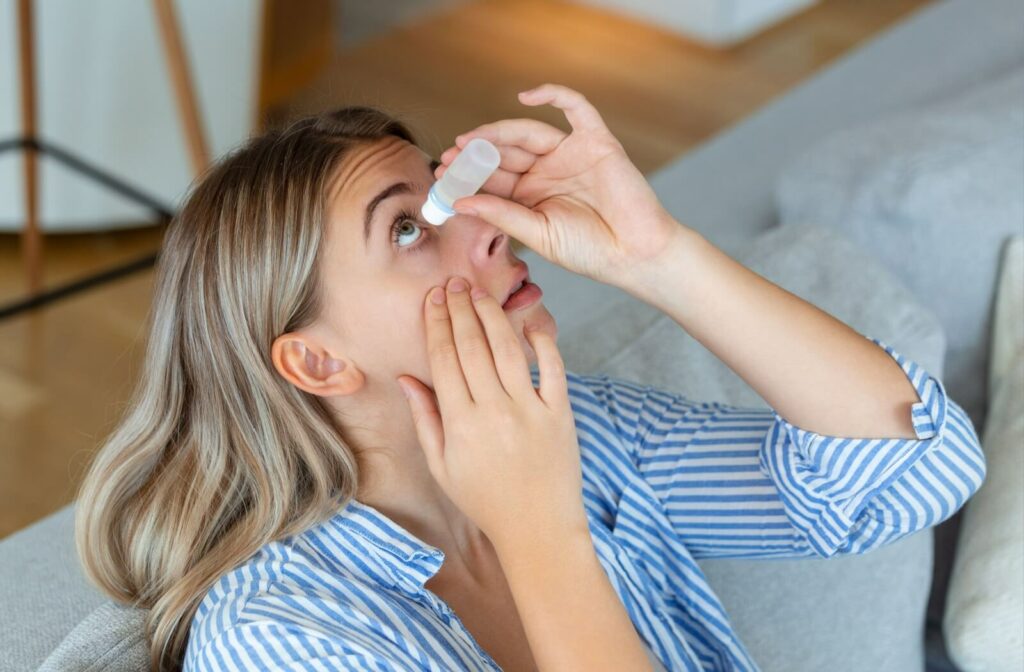That gritty, scratchy feeling in your eyes can turn simple activities like reading a book or working on the computer into an uncomfortable chore. You might find yourself blinking constantly, hoping for a moment of relief that seems just out of reach. This persistent discomfort can be frustrating and disruptive.
Dry eye often feels like a persistent, sandy irritation. This sensation is frequently accompanied by stinging, burning, or even periods of excessive watering as your eyes try to protect themselves.
If you’re experiencing these symptoms, come visit us at The Vision Place and take the first step towards comfort with our dry eye therapy services.
Common Signs & Symptoms of Dry Eye
A Gritty or Scratchy Sensation
One of the most frequent descriptions of dry eye is the feeling that something, such as a speck of sand or an eyelash, is stuck in your eye—even if nothing is actually there. This sensation is caused by friction on a poorly lubricated eye.
Stinging & Burning
A stinging or burning feeling is another common symptom of dry eye. This sensation can range from a mild annoyance to a more intense irritation.
Unexpected Watery Eyes
While seemingly unintuitive, unexpected watery eyes are also a symptom of dry eye. It happens when your body floods the surface of your eyes with tears in an attempt to provide lubrication. However, because your tear film is out of balance, your eyes remain dry and irritated.
Other Telltale Signs
- Eye redness
- Stringy mucus in or around your eyes
- Sensitivity to light
- Eye fatigue or blurred vision
- Difficulty with nighttime driving
- Discomfort while wearing contact lenses, which may require a contact lens exam
Why Your Eyes Feel This Way
Dry eye occurs when your tear film is out of balance. This delicate film has three layers: oil, water, & mucus that work together. When one of these layers isn’t working correctly, the surface of your eye can become irritated.
Aqueous deficiency dry eye occurs when your body isn’t making enough tears to keep your eyes lubricated.
Evaporative dry eye occurs when the oily layer of your tears is of poor quality and doesn’t effectively stop your tears from evaporating. Blocked meibomian glands along your eyelids are a frequent cause of this imbalance.
Everyday Triggers & Risk Factors
Certain factors can make you more likely to experience dry eye symptoms. Age is a common cause, as tear production can decrease over time. Some medications, certain health conditions, and environmental elements like wind or dry air can also contribute.
Simple Lifestyle Changes for Relief
You can make small adjustments at home and in your daily routine to help ease your symptoms.
Adjust Your Environment
Your surroundings can have a big impact on your eyes. A few changes can make a noticeable difference in how your eyes feel throughout the day.
- Use a humidifier to add moisture back into dry indoor air.
- Position car heaters or fans so they don’t blow directly on your face.
- Wear wraparound sunglasses when outdoors to protect your eyes from the wind.
Be Mindful of Screen Time
When you focus on a screen, you tend to blink less often, which can contribute to digital eye strain. Remember to take regular breaks, and follow the 20-20-20 rule: every 20 minutes, take a 20-second break to look at something 20 feet away.
Diet & Hydration Tips
Staying hydrated by drinking plenty of water helps your whole body, including your eyes. Certain foods can also support your eye health. Foods with omega-3 fatty acids, such as salmon, flaxseed, and walnuts, may help improve the function of the oil glands in your eyelids.
Professional Dry Eye Treatment Options
When lifestyle changes aren’t enough to manage your discomfort, an eye care professional can offer more direct, in-office dry eye treatments. These approaches are designed to address the underlying cause of your dry eye.
Prescription Eye Drops
These are different from the artificial tears you can buy over the counter. Some prescription drops can help your body produce more of its own natural tears. Others work to reduce inflammation that may contribute to your dry eye symptoms.

In-Office Procedures
Some modern treatments focus on improving the function of the oil glands in your eyelids. These simple procedures can help clear blockages caused by meibomian gland dysfunction and restore the natural flow of oil into your tear film. This improves your tear quality and helps reduce the quick evaporation that leads to dryness.
When to See an Eye Doctor in San Antonio
If your symptoms are persistent or affect your ability to perform daily activities like reading or driving, it may be time to schedule a visit. Ongoing discomfort is a sign that your eyes need a little extra support. An eye care professional can help you find a solution that works.
Get a Clear Diagnosis
Other conditions, like eye allergies or certain infections, can have symptoms that seem very similar to dry eye. This overlap can make it tricky to know what’s really going on. Your optometrist can help you determine the source of your discomfort.
A Long-Term Approach
Dry eye is often a chronic condition that requires ongoing management. While symptoms might come and go, they don’t typically resolve on their own for good. Finding a sustainable routine is key to keeping your eyes comfortable.
How an Eye Exam Can Help
A comprehensive eye exam allows us to have a look at your tear film and develop a plan to suit the needs of your eyes. It’s all about finding the right combination of strategies to bring you lasting relief.
At The Vision Place, we’re here to help you understand your options and find comfortable vision. We believe in empowering you with the knowledge you need to care for your eyes. If you’re tired of the gritty, burning feeling that plagues you, we invite you to book an appointment today.


